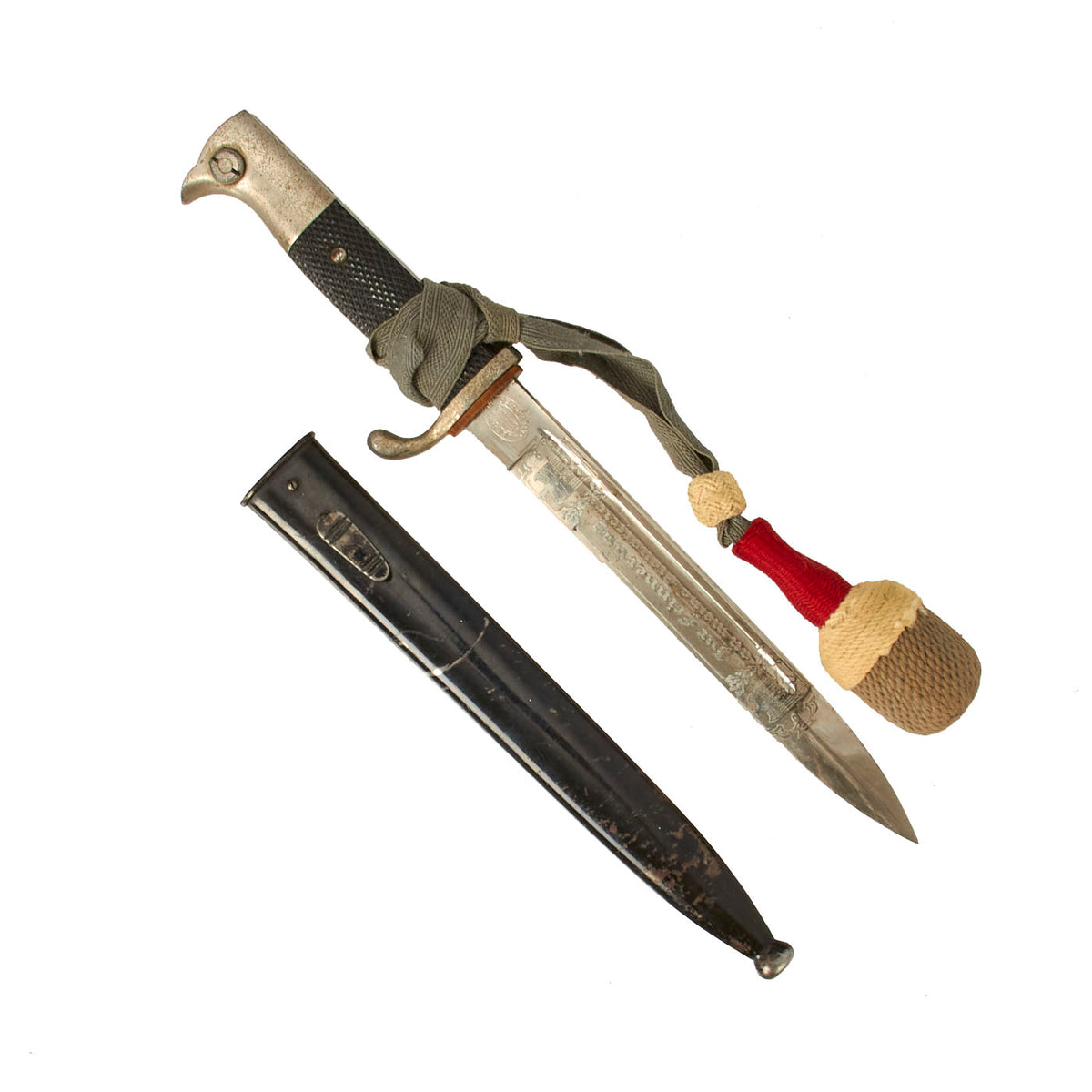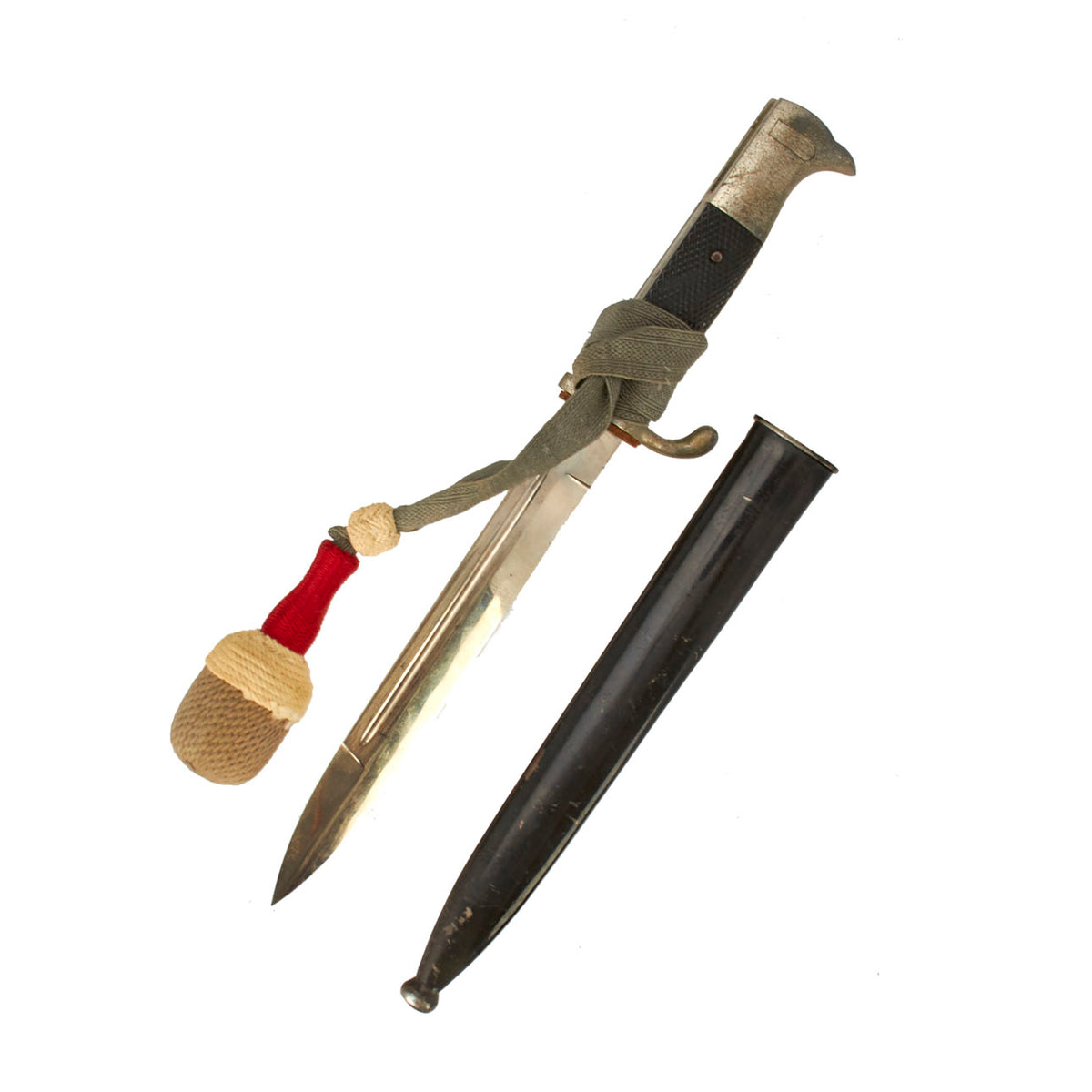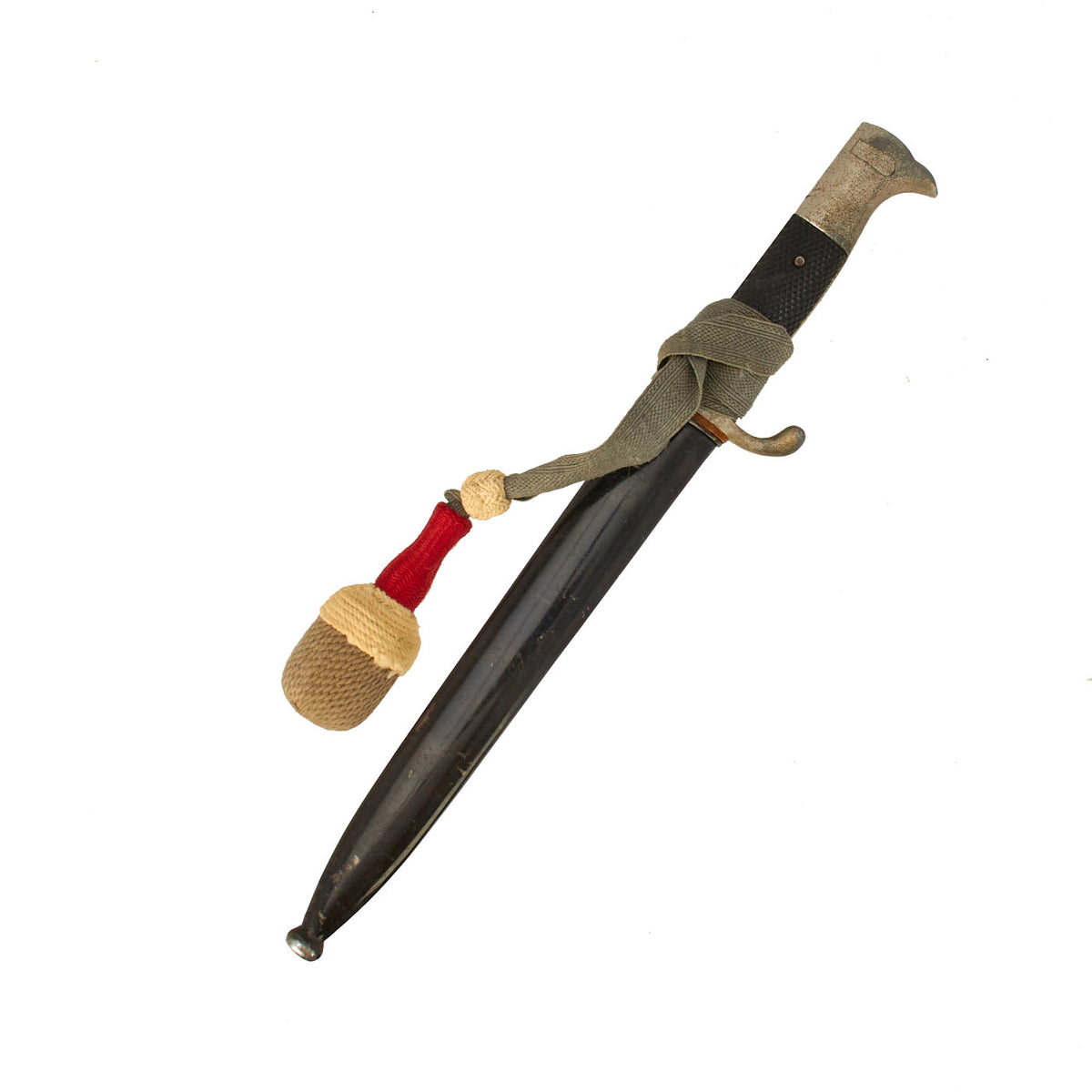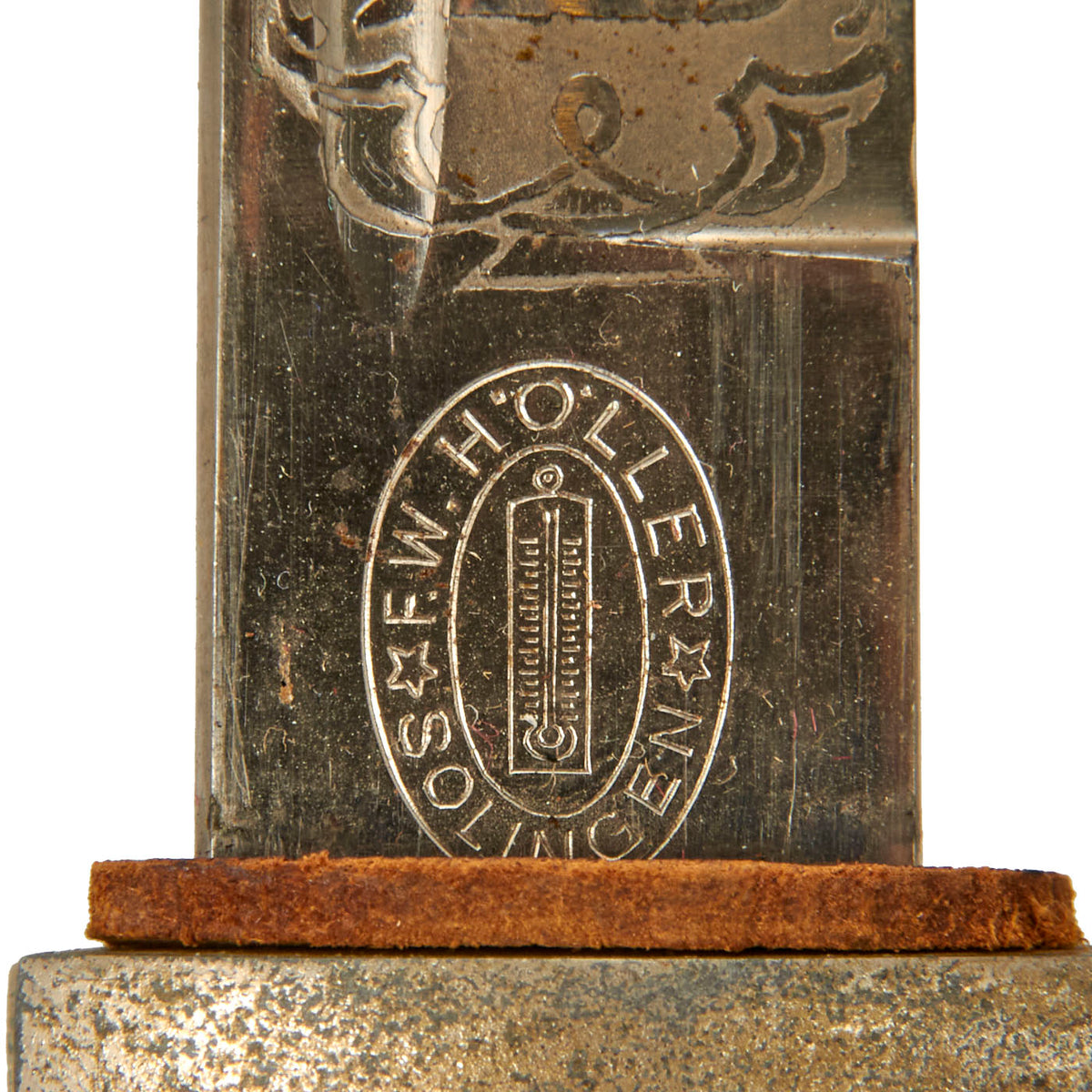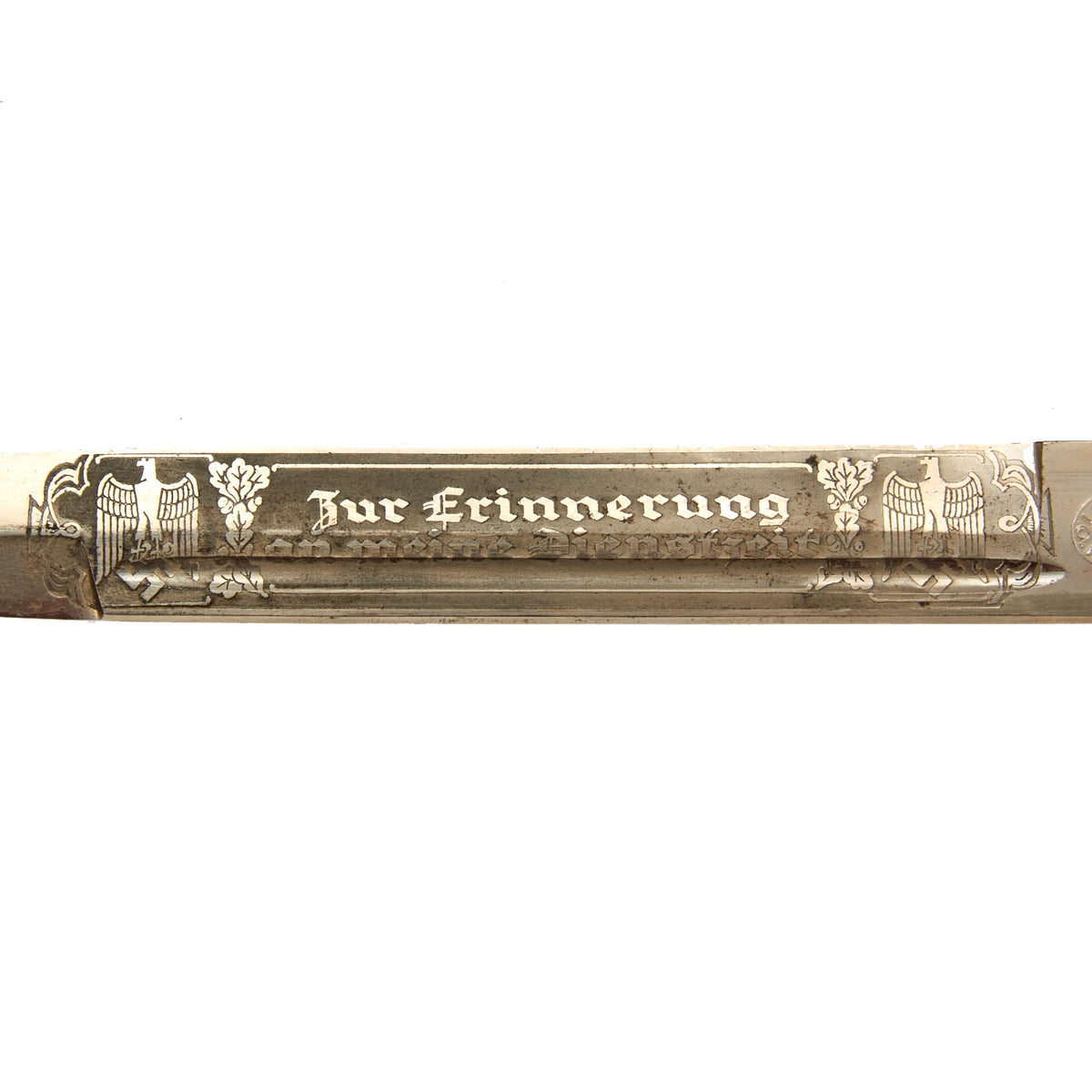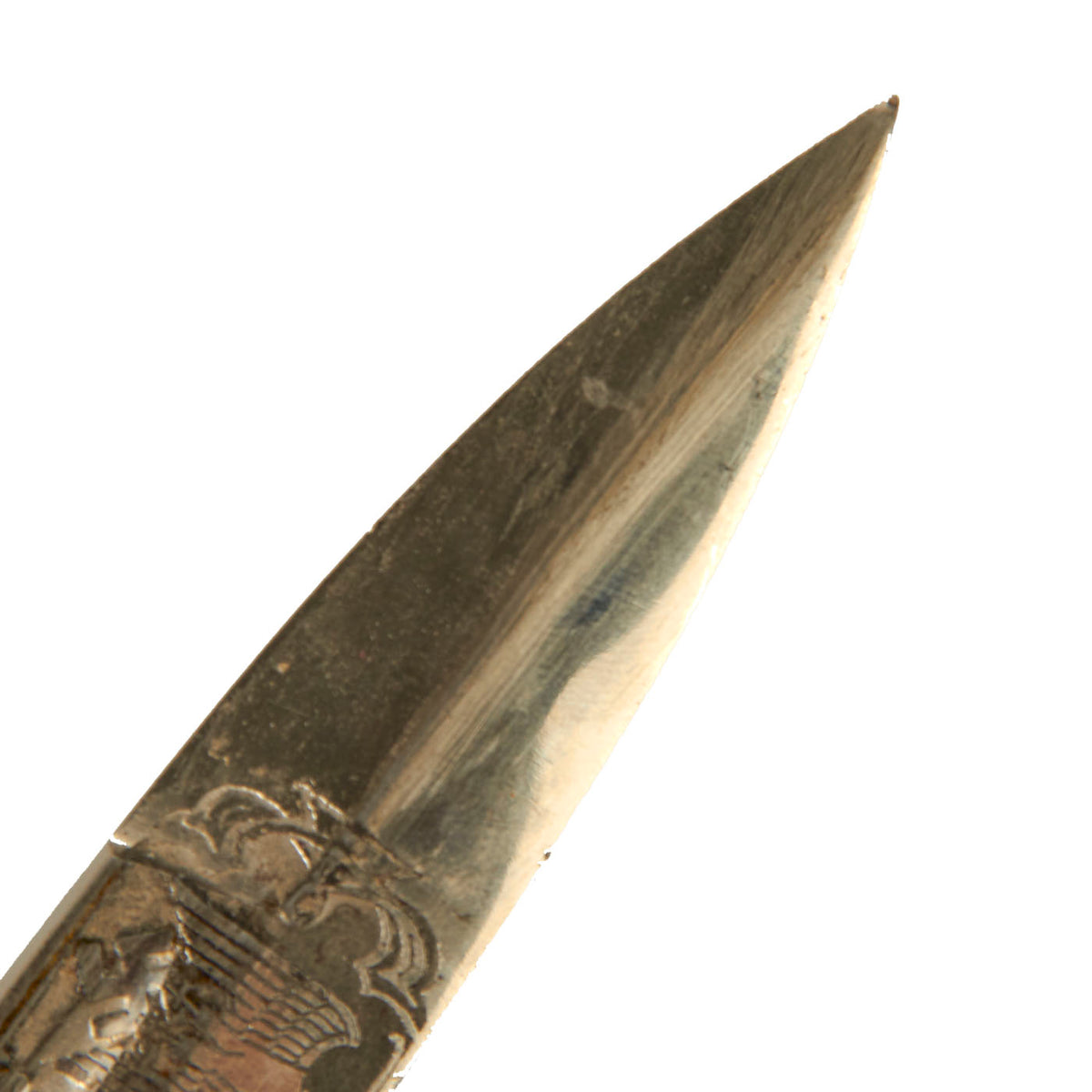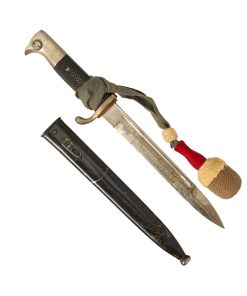Original German WWII Heer Single Etched Short 98k Rifle Bayonet by F.W. Höller with Scabbard & Troddel Knot Original Items
$ 695,00 $ 208,50
Original Item: Only One Available. The K-98 dress bayonet was a dress version of the combat style, and was worn by enlisted and NCO personnel for dress and parade occasions. The bayonets were finished with a high-quality nickel plating, with stag or bakelite grip plates and black painted scabbard. The choice of blade length was left to the purchaser, being nickel-plated short (20cm) or long (25cm) version. There was usually a red or green colored felt insert in the rifle slot and the bayonet was suspended from a black or brown leather frog. Some had a functional bayonet latch, while it was ornamental on some. Often they would also have a sword knot, or troddle, and the color would indicate the branch or rank.
Enlisted or NCO personnel were permitted to purchase K-98 dress bayonets with fancy etched blades. These etchings run the gamut from simple designs featuring the standard remembrance, Zur Erinnerung an meine Dienstzeit (In Memory of My Service Time), to very fancy, custom etched depictions, citing the individual’s regiment, unit, and sometimes even his name. Many blade factories offered unique etch patterns. The etch work was often state of the art.
This very nice example is in very good condition, and comes complete with the scabbard troddel knot. The bayonet has a has a very nice custom etched nickel plated blade. It has has a nice alloy hilt, which still has some of the original nickel plating, but does show overall wear and oxidation as well. The mortise button and blade release are fully functional, with an intact green felt insert. The grip plates are both lovely checkered black bakelite, and both are in great condition. They are retained by plated steel rivets which have dressed heads on the obverse.
Measuring 13.5″ (345 mm) with the scabbard on, this dress bayonet features a 7 3/4″ (200 mm) nickel-plated steel blade with unsharpened edges, remaining bright and crisp. It is engraved Zur Erinnerung an meine Dienstzeit (In Memory of my Service Period) on the obverse of the blade, flanked by two Army (Heer) eagle insignias on the left and the right, the type and insignias each separated by clusters of oak leaves, with full length fullers on both sides.
The ricasso is maker marked with a “losenge” style trademark logo that reads F. W. HÖLLER / SOLINGEN, surrounding the trademark Höller “Thermometer” emblem. This is a well-known maker from Solingen, the famous “City of Blades” in Western Germany, which produced many fine edged weapons.
F.W. Höller, Waffenfabrik (Weapons Factory), located in Solingen, the legendary “City of Blades” in western Germany. During the WWII Period they manufactured many SA and NSKK daggers, both with their “thermometer” trademark and later with the RZM code M7/33. They also produced numerous 98K bayonets and other edged weapons. The firm was founded in 1866, and registered in Solingen in 1883. By 1900 ownership had passed to Emil Höller, and it continued manufacture after WWII, finally closing in 1974. For more information please see J. Anthony Carter’s fine work GERMAN SWORD AND KNIFE MAKERS.
There is a troddel (tassel) knot wrapped around the handle, in good condition and by the color pattern we believe it to be for the 6th Infantry Division of the Wehrmacht. Accompanied by its black metal scabbard, magnetic, with frog stud, metal locket at the blade entry end held in place by a single screw, ball finial, the scabbard with multiple contact marks overall, tight frog stud.
An very nice example of a personalized German Short 98k dress bayonet by a well-known maker, complete with frog and troddel knot, ready to display!
Specifications:
Blade Length: 7 3/4″
Blade Style: Single Edge w/ Fuller
Overall length: 12 5/8“
Crossguard: 2 1/4”
Scabbard Length: 8 3/4″
6th Infantry Division (Wehrmacht)
Formed in October 1934 from Infanterieführer VI in Bielefeld, the division was mobilized on 26 August 1939 for the upcoming invasion of Poland. At that time, it consisted of the usual German infantry division elements: three infantry regiments of three battalions each, one three-battalion regiment of light artillery, one battalion of heavy artillery (from a separate artillery regiment, but attached to the particular division), a Panzerjäger (anti-tank) Battalion, a reconnaissance (Aufklärungs) Battalion, a Signals Battalion, a Pioneer (Engineer) Battalion, and divisional supply, medical, and administrative units.
When the Soviets launched Operation Bagration on 23 June 1944, the division was surrounded during the Bobruysk Offensive and completely destroyed.
Fast Shipping with Professional Packaging
Thanks to our longstanding association with UPS FedEx DHL, and other major international carriers, we are able to provide a range of shipping options. Our warehouse staff is expertly trained and will wrap your products according to our exact and precise specifications. Prior to shipping, your goods will be thoroughly examined and securely secured. We ship to thousands clients each day across multiple countries. This shows how we're dedicated to be the largest retailer on the internet. Warehouses and distribution centres can be located throughout Europe as well as the USA.
Note: Orders with more than one item will be assigned a processing date depending on the item.
Before shipping before shipping, we'll conduct a thorough inspection of the items you have ordered. Today, the majority of orders will be delivered within 48 hours. The delivery time will be between 3-7 days.
Returns
The stock is dynamic and we cannot completely manage it because multiple stakeholders are involved, including our factory and warehouse. So the actual stock may alter at any time. It's possible that you may not receive your order once the order has been made.
Our policy is valid for a period of 30 days. If you don't receive the product within 30 days, we are not able to issue a refund or an exchange.
You can only return an item if it is unused and in the same state as the day you received it. You must have the item in its original packaging.
Related products
Uncategorized
Uncategorized
Uncategorized
Uncategorized
Uncategorized
Uncategorized
Uncategorized
Uncategorized
Uncategorized
Angolan Rebel 1970s era 60mm Inert Display Mortar from Angolan Civil War Original Items
Uncategorized
Uncategorized
Uncategorized
Uncategorized
Band of Brothers ORIGINAL GERMAN WWII Le. F.H. 18 10.5cm ARTILLERY PIECE Original Items
Uncategorized
Uncategorized
Uncategorized
Uncategorized
Uncategorized
Uncategorized
